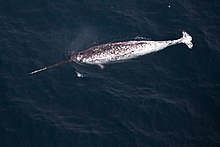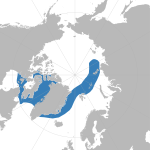
Back Narwal Afrikaans Monodon monoceros AN Nēohwæl ANG كركدن البحر Arabic حريش البحر ARZ Vwardol (Monodon monoceros) AVK Narval Azerbaijani Нарвал Byelorussian Нарвал BE-X-OLD Нарвал Bulgarian
| Narwhal | |
|---|---|

| |

| |
| Size compared to an average human | |
| Scientific classification | |
| Domain: | Eukaryota |
| Kingdom: | Animalia |
| Phylum: | Chordata |
| Class: | Mammalia |
| Order: | Artiodactyla |
| Infraorder: | Cetacea |
| Family: | Monodontidae |
| Genus: | Monodon Linnaeus, 1758 |
| Species: | M. monoceros
|
| Binomial name | |
| Monodon monoceros | |

| |
| Distribution of narwhal populations | |
The narwhal (Monodon monoceros), is a species of toothed whale, and the only member of the genus Monodon. Its closest living relative is the beluga whale, and a single case of interbreeding between the two species has been recorded. It is sexually dimorphic, as adult males are larger than females and have a single tusk that can be up to 3 m (9.8 ft) long. Several theories have been proposed for the function of the narwhal tusk, including its use in fights, in feeding or in sexual selection. The narwhal has a mottled pigmentation, with blackish-brown markings over a white background. It has a short dorsal ridge in place of a dorsal fin, which is thought to facilitate movement under the ice, or reduce surface area and heat loss. An adult narwhal is typically 3.0 to 5.5 m (9.8 to 18.0 ft) in length and 800 to 1,600 kg (1,800 to 3,500 lb) in weight. Carl Linnaeus scientifically described the species in his 1758 work Systema Naturae.
The narwhal inhabits Arctic waters of Canada, Greenland and Russia. Every year, it migrates to ice-free summering grounds, usually in shallow waters and often returns to the same sites in subsequent years. In spite of its carnivorous nature, it is hunted by polar bears, orcas and humans. Its primary food sources include polar and Arctic cod, Greenland halibut, cuttlefish, shrimp, and armhook squid. The narwhal is one of the deepest-diving cetaceans, with many individuals reaching depths of over 1,500 m (5,000 ft) in their search for prey. Social creatures, narwhals congregate in groups of up to 20 individuals. They mate in the offshore pack ice in April or May, and have a gestation lasting an average of 15 months. Like most other cetaceans, the narwhal uses clicks, whistles and knocks to communicate.
There are an estimated 170,000 living narwhals, and the species is listed as being of least concern by the International Union for Conservation of Nature (IUCN). The population is threatened by the effects of climate change, such as the reduction in ice cover, and human activities such as pollution and hunting. The narwhal has been hunted for thousands of years by Inuit in northern Canada and Greenland for meat and ivory, and regulated subsistence hunts continue.
- ^ Newton, Edwin Tulley (1891). The Vertebrata of the Pliocene deposits of Britain. London: Printed for H.M. Stationery off., by Eyre and Spottiswoode. doi:10.5962/bhl.title.57425.
- ^ "Monodon monoceros Linnaeus 1758 (narhwal)". PBDB.org. Archived from the original on 12 July 2020. Retrieved 11 July 2020.
- ^ Lowry, L.; Laidre, K.; Reeves, R. (2017). "Monodon monoceros". IUCN Red List of Threatened Species. 2017. doi:10.2305/IUCN.UK.2017-3.RLTS.T13704A50367651.en.
- ^ "Appendices | CITES". cites.org. Archived from the original on 5 December 2017. Retrieved 14 January 2022.
© MMXXIII Rich X Search. We shall prevail. All rights reserved. Rich X Search
